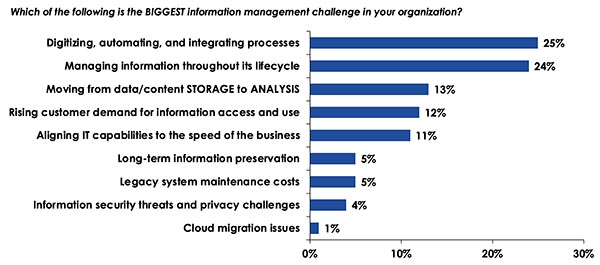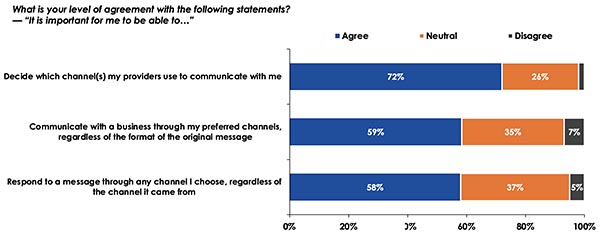- According to studies from the Association for Intelligent Information Management (AIIM) and the Harvard Business Review, not every company is properly aligning its digital processes.
- The issues that most commonly caused information chaos within companies included a failure to properly digitize, automate, or integrate processes, as well as breakdowns in managing information throughout its entire lifecycle.
- Paper-intensive firms that are attempting to digitize may encounter bottlenecks because paper-based content must be digitized before it can be read and sorted by a document management system.
By Colin McMahon
Introduction
In many ways, the phrase “digital transformation” has become something of a buzz term. It has appeared in articles for years, and usually relates to online adoption—anything from emails to cloud solutions to remote workflows. Anytime the internet gets involved, that’s considered digital transformation. Unfortunately, overuse of the term has reduced its impact and has also caused many print companies to think they’ve already achieved it. After all, they use email, they keep documents on servers…what else is there?
Regardless of any misconceptions, Salesforce defines a digital transformation as “the process of using digital technologies to create new—or modify existing—business processes, culture, and customer experiences to meet changing business and market requirements.” With this in mind, it’s understandable that the term has become so overused. It’s also easy to see why many organizations are not as digitally transformed as they believe. The internet is far from static—the past 12 months alone have brought a wealth of change, not just for the technology but for the culture and prioritization around its use.
If print service providers hope to remain competitive in the marketplace of tomorrow, they must fully understand and embrace the challenge of implementing digital transformation practices. In addition, they can’t fall into the trap of basing any changes on what was necessary in 2018, 2019, or even early 2020. Instead, they must develop a true comprehension of what is required for success right now.
COVID-19 Has Accelerated the Potential of Digital Transformation
When the COVID-19 pandemic hit the US business world in March 2020, it forced a radical shift for many firms. Regardless of industry segment, many organizations went from largely on-premises workforces to remote-based employees and on-site procedures that were built around social distancing and safety. Seemingly overnight, in-person sales meetings and trade shows became infeasible. Organizations of all sizes were forced to scramble so they could continue to communicate with and serve their current and prospective clients.
Very suddenly, many executives had to get used to running a business—even if it was a large, multi-location endeavor—from their own homes. Meanwhile, they also had to face the knowledge that many of their employees were struggling with changes of their own. From an infrastructure standpoint, this typically required a complete overhaul of how companies run day-to-day operations. In short, it meant that the IT department suddenly became even more integral to an organization’s success. Here’s the bad news—according to studies from the Association for Intelligent Information Management (AIIM) and the Harvard Business Review, not every company is aligning properly.
Struggling with “Information Chaos”
Prior to the COVID-19 pandemic, very few companies were prepared for a full-time remote workflow. In fact, AIIM’s research suggests that only about a third were prepared to make the leap. This lack of readiness impacted many businesses; suddenly, every single form of communication was digital. Gone were the watercooler conversations, mass company gatherings, or even just walking across the office to chat with a colleague. All at once, almost everyone had to rely on email, Microsoft Teams, Zoom, or some other platform to conduct even the most casual of conversations. Discussions that might have been completed in a couple of minutes in the past might have taken several days if one of the participants was slow to reply—and this was just on the internal side of the business.
According to the AIIM survey, the issues that most commonly caused information chaos within companies included a failure to properly digitize, automate, or integrate processes, as well as breakdowns in managing information throughout its entire lifecycle.
Figure 1. Lifecycle Information Management and Process Automation

N = 222 Total Respondents
Source: AIIM 2021, Recreated by Keypoint Intelligence
Data from Keypoint Intelligence corroborates these findings. In many cases, printing firms will incorrectly declare themselves “fully automated” even when certain processes have not been completely automated. While it’s a good start, partial automation will often create information siloes. For instance, imagine onboarding a client. The initial sales conversation goes well, client data is gathered by the sales rep and is automatically entered into the larger corporate system…but then nothing else happens. The automation then stops, and the valuable data will be unusable until someone notices that the cycle was broken. This represents a failure in information lifecycle management as well as a failure to properly digitize or automate processes. New information is great, but it won’t do a company any good if it’s stuck on a server that has not been properly or fully connected to a greater cloud system.
The Challenges and Benefits of Keeping Print-Based Workflows
For many industries, paper unfortunately represents a real problem when it comes to proper automation and strong information management techniques. One respondent to the AIIM survey noted, “Organizations that work at ‘the speed of paper’ are increasingly being rendered non-competitive and irrelevant….Information must be digitized and work processes must be developed or reworked, with a focus on digital first and automation wherever possible. This means that firms must adopt a posture of agility and responsiveness rather than one of passivity and reactivity.”
This might sound like dire news for the future of print, but paper-intensive industries like healthcare and legal certainly can’t just abandon print. Regulations and protective measures ensure that print will remain a crucial part of the workflow. Even so, paper-intensive firms that are attempting to digitize to improve their workflows may encounter bottlenecks because paper-based content must be digitized before it can be read and sorted by a document management system.
Customers’ individual communication preferences are also very important. According to Keypoint Intelligence’s most recent Annual State of Marketing Communications survey, consumers are increasingly demanding a say in the channels that organizations use to communicate with them. This means that firms might very well lose some customers if they don’t offer them an option for printed communications.
Figure 2. Opinions about Marketing Communications

N = 1,550 Consumer Respondents in the US and Canada
Source: Annual State of Marketing Communications Consumer Survey; Keypoint Intelligence 2020
The Bottom Line
At the end of the day, printed communications won’t be disappearing anytime soon. Even so, print service providers must take steps to better align their offerings for new, digitized workflows. Many print hardware providers offer in-house document management solutions, partly for this very reason. COVID-19 radically reshaped our world, and the monumental shift toward a deeper digital transformation was only one component of this movement. A true digital transformation reaches every aspect of a business, from internal communications to product design to corporate structure. Print companies must rebuild themselves to effectively handle and process information through digital channels, while also ensuring that their offerings still make sense in a post-COVID landscape. For example, designing paper with easy-to-read QR codes or other scanning features might better align with changing client preferences.
The digital transformation is not just a box that must be checked off before moving on to other priorities. It is an ongoing process, one that must change as often as technology itself does. Being digitally transformed today does not mean the same thing that it meant two years ago. Print companies that do not take steps to advance themselves now may risk being left behind in the continued information chaos of tomorrow.
Colin McMahon is a Senior Editorial Analyst at Keypoint Intelligence. He supports most of Keypoint’s Production services with podcasts, blogs, and other types of deliverables. A graduate of Concordia University, Mr. McMahon is a published author, an avid researcher, and enjoys working with the latest in imaging hardware.














